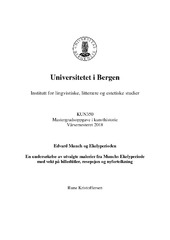Edvard Munch og Ekelyperioden. En undersøkelse av utvalgte malerier fra Munchs Ekelyperiode med vekt på billedtitler, resepsjon og nyfortolkning
Master thesis
Permanent lenke
https://hdl.handle.net/1956/18149Utgivelsesdato
2018-06-15Metadata
Vis full innførselSamlinger
Sammendrag
When the world famous Norwegian artist Edvard Munch (1863-1944) died, he left his entire collection of artwork to the city of Oslo. The collection included 1099 paintings from Munch’s artistic career. Among these paintings, approximately 400 were from Munch’s late period (commonly known as the Ekely period). These paintings had never previously been exhibited, and were therefore left untitled by Munch. Due to this, it was left to the reception, and primarily the Munch Museum, to title them. How this was carried out, and what the motivation behind the given titles was, has, until now, never been the subject of research. There has not been any research regarding the question of how these titles may have influenced the later reception of Munch’s Ekely period either. A picture without a title given by the artist is hardly uncommon in art history. However, this mainly applies for artwork before the 18th century exhibition practice when titles were required on all exhibited art. Munch’s Ekely period, where several hundred picture titles date back to the reception alone, can therefore be considered a unique case in our time. In this thesis, I study a selection of paintings from Munch’s Ekely period with an emphasis on picture titles, reception and new interpretations. The thesis question is as follows: How can we relate to the many (and in many cases, somewhat different) reception titles given to the paintings from Munch’s Ekely period in a way that can also provide new interpretations of this period? My analysis shows that an interest in the variety of titles and in the connection between title, interpretation and in what context the titles have occurred, illustrates how dynamic many of the paintings from the Ekely period really are.
